Press for fuel briquettes: options for making installations for pressing sawdust with your own hands
Heating with sawdust or shavings is a common thing for residents of our country, borrowed from European countries.Their popularity is due to the low cost of raw materials and their good specific calorific value during combustion. By creating a homemade briquette press, you can get high-quality fuel for practically nothing.
We will tell you how to make a simple and inexpensive machine for producing briquetted fuel. The article we propose shows the design and gives assembly tips. The production technology and requirements for the initial wood material are given.
The content of the article:
Briquette creation technology
The production of pellets and briquettes from wood waste by pressing is a long-established process. Therefore, when creating a homemade machine to obtain high-quality “European firewood”, you do not need to invent anything, but you can apply existing developments.
Description of the physics of the process
The use of bulk wood material for heating finds its application in small boiler rooms and furnaces. Sawdust provides the same energy as wood of similar mass and moisture content, but storing it in its natural state creates dirt and dust. Therefore, such waste is pressed into briquettes of various shapes.
With some assumptions, we can say that wood consists of fiber (cellulose) and its binding substance - lignin. Each piece of sawdust and shavings retains its integrity thanks to this polymer. In order to establish strong connections between the individual pieces, they also need to be glued together.
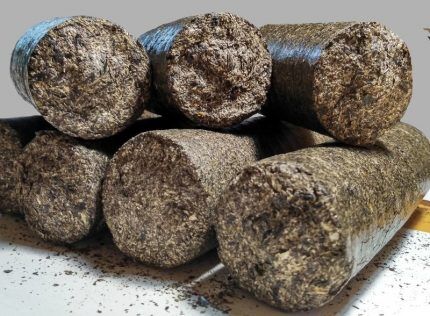
During the pressing process, strong pressure is applied to the sawdust, as a result of which lignin is released from it and holds the material together in the mold. This bond, of course, is not as strong as in solid wood, but it is enough so that the resulting briquette does not fall apart.
The amount of lignin in wood relative to dry mass depends on the tree species:
- fir: 30%;
- pine: 27%;
- spruce: 27%;
- aspen: 22%;
- birch: 19%.
The higher the percentage of lignin content, the less pressure is needed to release it. Therefore, it is easier to independently produce briquettes based on sawdust from fir than from birch.
In addition to the classic production press bulk fuels There is also an extrusion machine. The essence of its work is that, under the action of a screw, the substance passes through a gradually narrowing channel.
This creates very high pressure. However, implementing this option at home is complex and requires specific knowledge, so it is better to focus on models with a mold.
Use of adhesive
In the industrial production of pressed fuel, machines are used to create pressure in the range of 500 – 3000 atm. Some manufacturers (for example, the German company RUF) form a briquette through a combination of compression with a force of 2000 atm. and heating the raw materials to a temperature of 150°C. The density of such products reaches 1.2 kg/dm3.
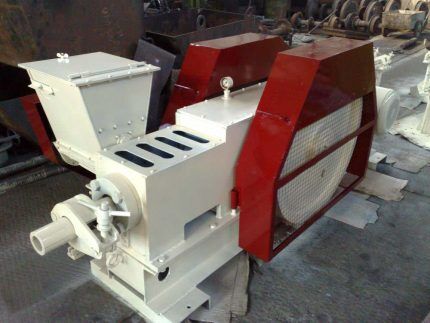
If you make a briquette press from scrap material with your own hands, you will not be able to achieve such characteristics. Therefore, the products will definitely have a lower density and be more prone to crumbling.
Compensate for insufficient lignin release and achieve greater strength sawdust briquettes possible by adding a third-party adhesive, such as:
- Slurry. The required mass fraction of this binder dissolved in water is from 5 to 10% of the total weight.
- Wet corrugated cardboard.
- The cheapest wallpaper glue diluted in water.
The percentage of corrugated cardboard or glue is determined experimentally, since it depends on the size of the sawdust, its humidity and the pressure created in the mold.
Requirements for raw materials used
Even when using industrial equipment, it is difficult to obtain high-quality briquettes or pellets from wood waste if their thickness is more than 4 mm. The size of the material for homemade devices should be smaller. This is due to lower pressure and lack of heating of the raw material.
Ideally, the sawdust diameter and chip thickness should not be more than 2 mm. The vast majority of wood waste fits these parameters.
But there are times when the raw materials are clogged with small branches, wood chips or wane (pieces of bark). Then, before pressing, to obtain a homogeneous mass, it is necessary to carry out preliminary preparation - crush the material by passing it through a crusher.
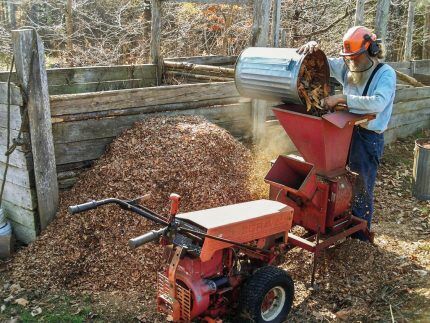
To achieve good briquette density, you must avoid raw materials clogged with grass, sand or soil. The soil-vegetative layer, unlike clay, does not have astringent properties, so the pressed product will crumble easily.
You also need to comply with the percentage ratio of the amount of bark - it should not be more than 5%. It is impossible to measure this, but visually sawdust with a significant amount of wane appears darker. The sawdust must be dry. Increased humidity leads to greater briquette looseness and a decrease in its specific calorific value.
You can dry the raw materials in the summer either in the sun or in a ventilated area. In winter, drying should be carried out in a veranda or other utility room with a slightly positive temperature. For more intense evaporation you can use forced ventilation.
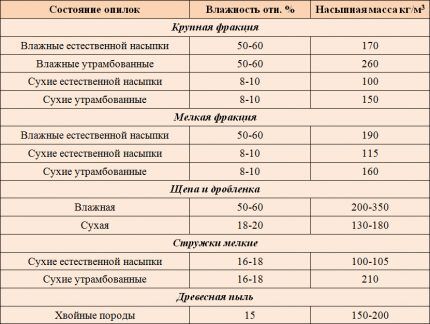
If the pressure in a homemade press for making briquettes from sawdust is insufficient to release lignin, then the raw materials are not dried, but rather soaked in water along with an additional fastening agent. In this case, better homogeneity is achieved during mixing, and excess moisture will be removed during compaction.
Basic elements of the press
The main elements of an ordinary press are a mold (a glass into which the bulk substance is placed), a piston and a pressure-creating mechanism. It is not difficult to make them yourself, as they are typical for briquetting machines.
Mold device
The glass into which sawdust or shavings are poured is called a mold or chamber.The parameters of the briquette will depend on its geometry.

Typically the chamber is constructed from scraps of round or shaped steel pipe. The base of the piston, which enters the glass, is cut out of a thick-walled (at least 3 mm thick) plate.
When making a mold, you need to take into account the ratio of the following quantities:
- cross-sectional area of the mold (s, cm2);
- applied pressure to the piston (u, kgf);
- specific pressure on raw materials (p, kgf/cm2).
These quantities are related by the relation:
p=u/s
Briquettes using an additional binder hold their shape well if they are formed at a specific pressure of more than 150 atm. (1 atm. ≈ 1 kgf/cm2). Based on the possibility of the force generated by the piston, the cross-sectional area of the chamber is calculated.
For example, if there is a 10 ton hydraulic jack, then:
s < u / p = 10000 / 150 = 67 cm2.
For such conditions, a profile square pipe with a side length of 80 mm or a round pipe with a nominal diameter of up to 90 mm is suitable.
The length of the resulting briquette (l) depends on the height of the mold (h), density of raw materials in the original dry (q1) and briquetted (q2) condition:
l = h * (q1 /q2)
In addition, after the first compression, you can pour the chips into the glass again and repeat the procedure. In this way, you can bring the length of the resulting product almost to the height of the pressing chamber.
During the compression of sawdust, moisture is released from the briquette. In order for it to come out freely, the chamber is perforated with small but frequently spaced holes.

After the briquette is formed, it must be removed from the mold. Using a spring and a false bottom, as is often recommended on the Internet, is impractical. High pressure completely compresses the spring, so over time its shape becomes distorted, causing it to lose its properties.
Therefore, you need to either make a detachable bottom of the mold and push out the briquette, or build a collapsible cup. In the second case, you will need to make an additional shirt for him from a rod.
Available methods of creating pressure
There are three common ways to achieve pressure that are well suited for a homemade fuel briquette press: using a lever, a hydraulic jack or a screw. Each of them is good in its own way, and their implementation in practice is not very difficult.
Use of muscular strength and leverage
Usually a metal pipe is used as a lever. It should not bend under the influence of human muscular strength. For example, a reinforced water pipe with a diameter of 40 or 50 mm with a wall thickness of 4 - 4.5 mm is suitable.
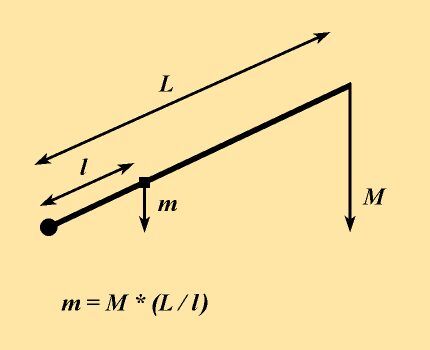
The length of the lever and the distance from the fulcrum to the connection with the piston are chosen not only based on achieving the desired pressure. Another important parameter is the depth of immersion of the piston into the glass (h, cm).
It is calculated using the formula:
h = R * (l / L)
Here R (cm) is the height to which the end of the lever will fall.
It is advisable to make the structure in such a way that the depth of immersion of the piston is sufficient to form a briquette without repeated compression with preliminary addition of material. This will greatly increase the production rate.
The required piston immersion depth (h, cm) can be calculated knowing the initial dry (q1) and briquetted (q2) density of raw materials and height of the glass (H):
h = H * (1 – q1 /q2)
If for some reason an error occurs (usually due to incorrect determination of the initial density of the raw material) and the depth of immersion of the piston is not enough to impart the required hardness to the product, then it is not necessary to digest the entire structure.
You can either reduce the height of the glass, or, adding sawdust, press one briquette in two or three passes.
Application of hydraulic jack
To create strong pressure, hydraulic devices are used, such as the usual bottle jacks. As a rule, in a household where there is a car or other equipment, such hydraulic units are available, but their carrying capacity may be insufficient.
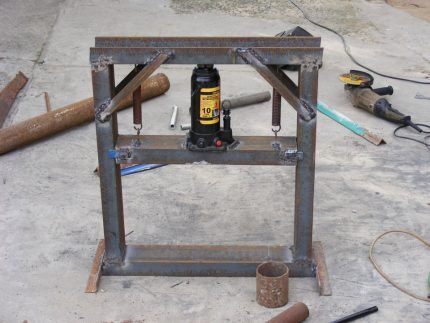
Jacks are inexpensive. Thus, models designed for 30-40 tons can be purchased for less than 5 thousand rubles. And with such indicators it is already possible to obtain briquettes of large cross-section or several (3-5) copies of regular size at once.
To produce several briquettes at the same time, the required number of molds are placed in a row. The middle moving frame must be strong so that it does not bend over time. It is best made from an I-beam or thick-walled profile pipe.
The pressing process itself takes longer than when using a lever design. However, the use of a powerful hydraulic jack allows one to achieve much greater specific pressure on the workpiece. The briquettes are more even and dense and already have an attractive presentation.
Screw pressing mechanism
The operating principle of a manual screw press is similar to a lever press, only the applied force is transmitted at an angle of 90°. The larger the handle diameter and the smaller the thread pitch, the greater the pressure increase factor.
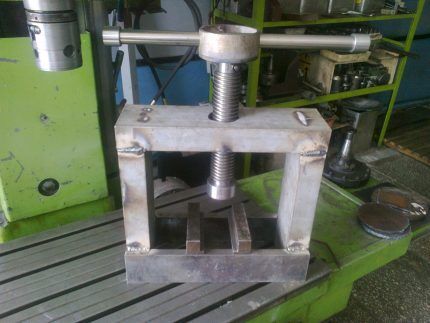
This design also allows for greater pressure to be generated than a lever-based machine. Its significant disadvantage is the slowest operating speed among the presented options.
However, the advantages include:
- simplicity of design;
- the opportunity to buy such a press for little money with minor modifications for briquetting needs;
- small size.
When working with a screw press, you should not use it “all the way”, when physical strength is no longer enough to turn the mechanism. In this case, the force applied by a person acts on the thread on one side, and on the other (at 90°) is the resistance force of the resulting briquette. This will lead to rapid thread wear or breakage.
In order not to overdo it and not break the mechanism, you need to achieve a sufficient result on test copies and either install a retainer or make a mark on the thread with a marker, marking its maximum allowable position.
Conclusions and useful video on the topic
Making a homemade lever press.Manufacturing of main parts and description of the operating principle:
Refinement of the machine design and the briquette pressing process itself:
Machine for simultaneous production of several briquettes based on a hydraulic jack:
It’s not difficult to make a sawdust briquetting machine yourself. You can choose to use a lever, hydraulic or screw principle for creating pressure. But we must remember that the quality of manufactured products will depend not only on the assembled mechanism, but also on the preparation of raw materials.
A correctly set up process will help provide your farm with high-quality and cheap fuel and even organize its sale.
Would you like to talk about how you made briquettes for heating with your own hands? Do you have valuable recommendations on the topic of the article that you are willing to share with site visitors? Please write comments in the block below, post photos here and ask questions.




Principles of calculations and formulas (simple), thank you for that. However, having seen enough of everything (taking into account the fact that I never had to do anything with my hands), I had to invent a hand press of my own design, and also execute it (with my own hands), despite the fact that the task was set “from what is available”, in garage basement). Yes, everything worked out.And the design turned out to be so original that not a single video (and I watched them - wow!) has nothing even close!!! :)) People who were interested in this topic also say that they have never seen anything like it ! But in winter, the press will have to be brought to the final idea, that is, to add the possibility of both hydraulics and pneumatics, that is, the idea is universality and maximum convenience, choice and variation, in short: - whatever your darling desires :))! By the way: - there is one piston, on the lever, and there are nine dies (forming dies)! , however, as many as you like - at least one, at least two, at least six, at least nine, however, you can have more, if anyone needs it :)) About the same! I believe that you can draw a patent, however, in your little home (why it would DIED) you don’t want to apply for a patent! (I'm fed up with Russian-generos!) It's easier for mother in Russia! (however, in Russia they already use my ideas, although they stole the documentation! And the GDP itself - the facility was opened, with great fanfare!!! And this is ours, from Novorossiya!!!, by the way, transnational companies have already slammed and used it! But This is a completely different area and has absolutely nothing to do with fuel briquettes. However, in my head, these developments have accumulated..., for some reason Western engineers did not get to them,) Sorry for the detailed comment.